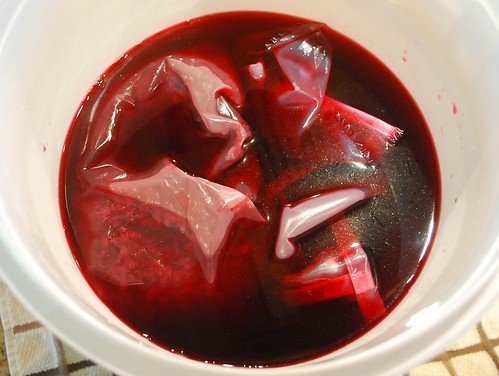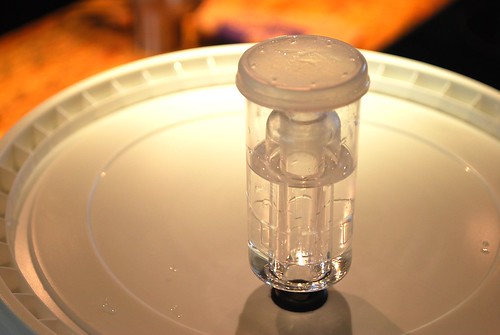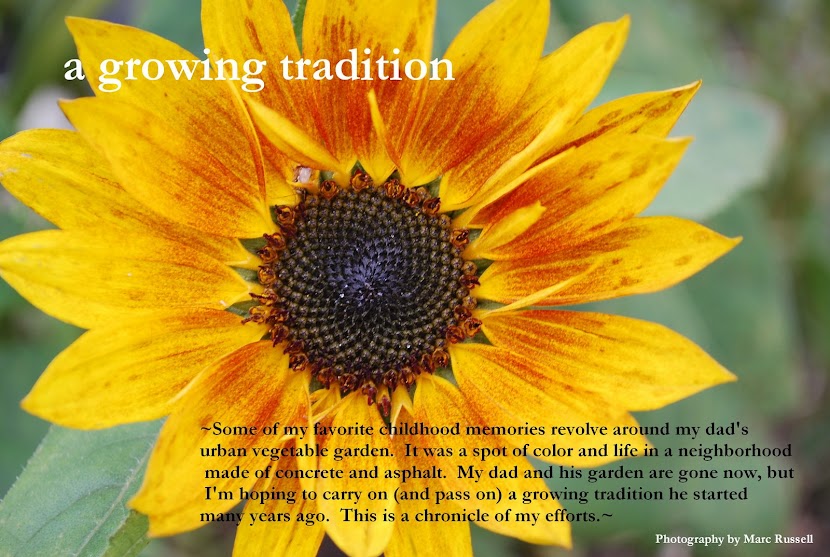
When Borders bookstore went out of business last year, I made several trips during the last few weeks of its life to raid the gardening and cooking sections. When all was said and done, I ended up with a large stack of books, and Terry Garey's "The Joy of Home Winemaking" was one of them.
I've been wanting to learn the craft of home winemaking for a while now. I think it all started when I watched the movie Anne of Green Gables on PBS (I think I was about 10 years old at the time) and was intrigued when a young Diana Barry, with a little help from Anne, got drunk off of Miss. Cuthbert's homemade red currant wine. Fast forward twenty years later, I bought my first bottle of red currant wine from a local farm while we were living in Massachusetts, and well... let's just say I wasn't exactly smitten with the stuff. The flavor of the wine was fine enough, but it was awfully sweet. I began to think that most commercial fruit wines were produced this way and unfortunately for me, I prefer my wines on the drier end of the spectrum.
Anyway, not too long ago, it dawned on me that all of our currant shrubs (courtesy of our landlord) might produce enough fruit this year to kick start this new endeavor of mine. If the birds stay away, I think we'll have enough red, white and black currants to make several gallons of wine. Like most hobbies (gardening being one of them), I'm expecting a steep learning curve in the beginning and lots of terrible wine along the way. But I've always believed that it's partly the mistakes that make learning a new craft all the more interesting and exciting.

I was expecting that my first wine would be made from currants, but thanks to our kind neighbor who introduced me to them, it will be made from most of the juneberries I picked this past weekend. It seems somehow more fitting that my first attempt at making wine would involve a wild edible fruit. I'm sure this was how it was done centuries ago before the first European wine grapes were ever cultivated. And it just so happens that I found a recipe (or should I say 'guide') for making juneberry wine online. (Jack Keller maintains a rather impressive site containing tons of recipes and advice for winemaking novices.)

Last Saturday, we made a trip to the Vermont Homebrew Store to set some supplies (a convenient 5 minute drive from our place). I spent about $75 but I'm sure you could get started on much less depending on what you already have lying around the house. (Jack Keller has a great list of basic supplies you would need in order to get started.) In fact, one of our neighbors kindly gave me a one gallon glass apple juice jug to use during the secondary fermentation stage of this project. (I don't think I'll make any batches larger than a gallon until I get the hang of this as one gallon of awful wine down the drain is not as heartbreaking as say three or five.) I've also sent word to a few of our friends to save their empty wine bottles.
I won't go into detail about what I've learned so far about the basics of home winemaking as I am in no position to be giving any sort advise on this subject at this point of the game, but I thought I'd at least describe what I did, along with my observations, here more for my own sake than anything else (in the event this wine actually turns out well). In any case, I woke up early on Sunday to get things started. I ended up using the ingredients listed in Jack Keller's third recipe but referred to some of the advice given in Terry Garey's book when putting it together.

I started out by mashing 3 lbs of juneberries in a large pot and brought it to a boil along with 6 cups of water and the juice of 2 lemons. After it simmered for about 10 minutes, I poured it into a nylon jelly bag that I'd placed inside my primary fermenter. Then I brought another 8 cups of water to a boil, into which I dissolved 2 1/2 lbs of sugar, and poured this into my primary as well. Into this mix I added 1 lb of minced raisins in a second jelly bag. I then covered the bucket and allowed it to cool down for a couple of hours. When the mixture (or 'must') was lukewarm, I stirred in 1 teaspoon of yeast nutrient and 1 crushed Campden tablet, which I'd dissolved in a small amount of the must first. (I did notice that the color of the must lightened a bit when I added the tablet, but it still retained much of its ruby red color.) Then the top went back on but this time fitted with an airlock.
At this point, there was a strong yet lovely scent of almonds or amaretto to the must, which I'm sure was imparted by the seeds. The smell subsided after it sat for a while and I was afraid that the addition of the raisins would overpower the flavor of the juneberries. I guess I'll find out eventually.

Twelve hours after I added the Campden tablet, I stirred in 1 teaspoon of pectic enzyme and recovered (late Sunday night). Twelve hours later, I sprinkled a packet of Champagne yeast over the surface of the must and recovered again. Within a few hours, I could tell that fermentation was starting as the airlock started to release gas.
Marc has been given the task of giving the must a gentle stir once a day while I'm away. After 5 days, the nylon bag containing the juneberries will be removed and the must will be allowed to ferment for another 5 days before the raisins are removed and the must is siphoned to the secondary fermentation vessel if all goes well. I'll be sure to provide updates as we go along.
(In case you're interested, here is a glossary of basic winemaking terms.)






I still remember picking chokecherries as a kid. My mom made wine out of them one year. I really liked picking them all, but I don't think my mom liked the wine much.
ReplyDeleteMy husband makes wine using kits and last fall he made some hard cider for me. I lookf forward to the day I can harvest enough fruit to make juices/wines out of them.
ReplyDeleteJack Keller is the king of fruit wine advice. It is fun to experiment but winemaking does require a lot of patients. It is amazing how age changes the flavor. I wish you the best of luck and am looking forward to updates.
ReplyDeleteI'm thrilled for you! How exciting! You'll be smitten,I'm sure. This reminds me, I've got to transfer our wine again soon. I really should be bottling it, but I've read that keeping it large volumes for lengthier amounts of time can add depth to the flavor of the wine. I hope so because I'm really procrastinating. We fermented this batch in August, or was it September? Hmmm?
ReplyDeleteThis site is amazing and very nice and i like this site and i hope every one like it!
ReplyDeleteLooks good! You'll have to try hard cider this fall.
ReplyDeleteHome wine making Home Wine Making is an exciting and joyful work.It requires lots of patience till it is ready to use but Jack Killer provides tons of recipes and advice for winemaking novices.
ReplyDeleteHello, i believe that i noticed you visited my blog so
ReplyDeletei got here to return the choose?.I am attempting to in finding things to enhance my web site!
I suppose its good enough to make use of some of your concepts!
!
Here is my weblog - golf buddy gps tour [champions-of-light.com]
We had a cluster of ancient flowering plumb trees that produced a good crop about every other year. Father made wine from them.
ReplyDeleteThis is awesome! I just discovered a Saskatoon berry bush in my yard, right next to another cherry tree that I didn't know was there! Anyways, I've got wine on the mind. I've made dandelion wine the past couple of years and I'm just finishing up the first stage of ferment on a batch of rhubarb wine (I have no idea how that is going to turn out). Check out my blog if you're interested! www.breezydidwhatnow.com I realize this is an OLD post but thank you for sharing!
ReplyDeleteI am new to this stuff and had a bunch of Juneberries to do something with. I looked at the recipe from Jack Keller and am trying your version of it. First, how did your wine turn out? Second, neither your version or the Jack Keller version mention the use of stabilizers or de-gassing etc. How is all this incorporated in the process? Rod Emly r_m_painting@yahoo.com
ReplyDeletekd 12
ReplyDeletebalenciaga speed
yeezy shoes
kd 11 shoes
calvin klein outlet
off white clothing
ultra boost
supreme
kd 12 shoes
coach outlet online
best in uk
ReplyDeletebalenciaga shoes
ReplyDeleteyeezy supply
golden goose outlet
bape hoodie
jordans
golden goose sneakers
jordan shoes
kyrie 6
yeezy shoes
lebron shoes